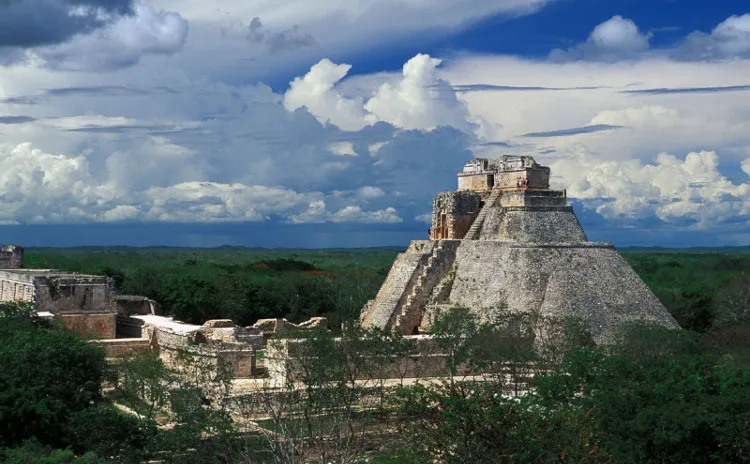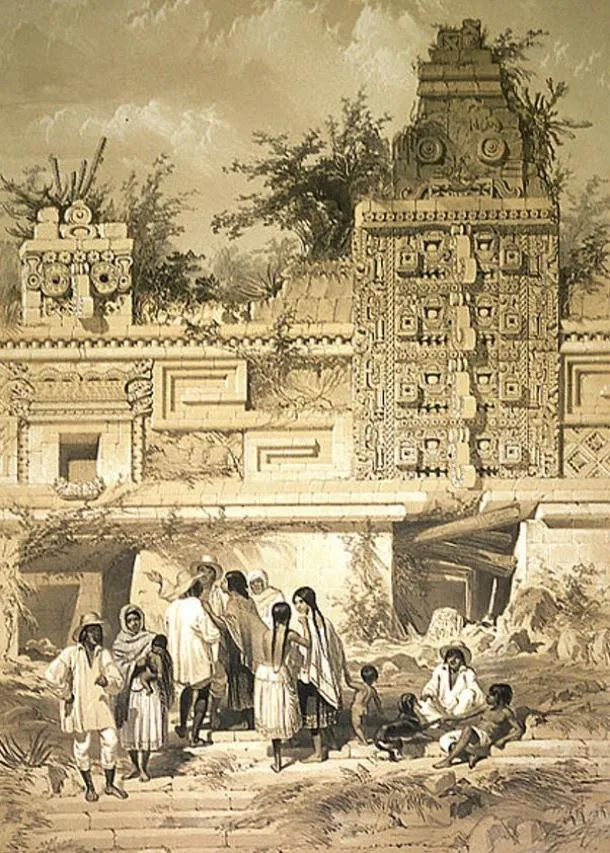The Maya civilization, with its unsolved mysteries, has always intrigued humanity. Despite being studied for years, the dense jungles continue to hide countless ancient relics, and the story of the Maya is still incomplete. Among these, the ancient city of Uxmal stands out as a brilliant architectural gem inviting visitors to explore the grand remnants of a past era.
Uxmal, alongside Chichen Itza and other cities in the northern Yucatan Peninsula, rose again after a period of decline that affected most other Maya cities. This city was once an important political and cultural center, playing a key role in the development of the Maya civilization in Mexico.
Mystical Historical Marks and Power Struggles
The ancient history of Uxmal remains a mystery, but research indicates that by the late tenth century, the city was ruled by Tutul Shiv. From the thirteenth to the fifteenth century, Uxmal engaged in fierce wars with Chichen Itza and Mayapan for supremacy over the Yucatan Peninsula. This conflict ended in 1441 with the fall of the Mayapan dynasty, which had seized Uxmal in the thirteenth century.
The Pain of Loss and Destruction of Heritage
In 1521, the Spanish conquered the land of the Maya, but Uxmal was already deserted. The Maya people had abandoned the city hundreds of years earlier, around the ninth and tenth centuries, and no one knows where they went.
The Spanish conquerors, particularly Bishop Diego de Landa, inflicted irreparable damage on Maya culture. They destroyed countless manuscripts, burned written records, and obliterated the cultural and scientific heritage of the Maya. Only three Maya manuscripts remain today, but they are enough to astonish humanity, indicating the profound wisdom of the Maya.
Professor Michael Douglas Coe of Yale University, a linguist and writing expert, once said: “Our knowledge of ancient Maya is just a fragment of the entire picture because among the thousands of books detailing their knowledge and ceremonies, only a few have survived into modern times.”
Before mysteriously disappearing, the Maya civilization built over 100 different cities, with an estimated total population of about 14 million people. Researchers are still on a journey to find Atlantis, the ancestors of mysterious civilizations in Central and South America, which includes the Maya civilization.

Uxmal, an ancient city located on the Yucatan Peninsula, Mexico, is a testament to the grandeur of the Maya civilization. With its distinct Puuc architecture, Uxmal is an important archaeological site where we can unravel the mysteries of the Maya.
During its prosperous period from 800 to 900 AD, the city was home to more than 20,000 people. The formation of Uxmal remains a mystery, but legend tells that a dwarf magician, born from an egg, built the city in just one night.
Mesoamerican Pyramids: A Crossroads of Spiritual World and Power
Mesoamerican pyramids, unlike the tombs of ancient Egypt, are places of ceremony and worship. Religion played a crucial role in the spiritual lives of the Maya. They revered deities such as the Sun God and the Water God, believing these gods had great influence over their crops.
Carved stones, known as tetun (tree-stone), feature hieroglyphs describing genealogical rulers, war victories, and other accomplishments. Each pyramid has a sanctum on top where religious ceremonies take place. The grandeur of these pyramids, with intricate designs depicting gods and rulers, underscores their intermediary role between humans and deities.
Major urban centers like Uxmal demonstrate a deep understanding of city planning. Famous buildings, such as the palaces of officials and ceremonial structures, are built atop hills to enhance their grandeur. Stone structures are designated for officials and priests, while the common people lived in small huts.
Architecture of Uxmal: A Harmonious Blend of Thought and Nature
Unlike many other ancient Maya cities, Uxmal was not built according to a set geometric plan. Instead, the city was designed based on astronomy and hilly terrain. Uxmal’s limestone structures were built along a north-east axis, with fortress walls surrounding the sacred center. Most buildings were constructed following the Puuc architectural style.
Puuc style divides buildings horizontally into two parts: a flat lower section and a richly decorated upper section resembling a mosaic. Houses of high-status individuals often have sculptures on the doorways and corners.

The Pyramid of the Magician, standing at 35 meters with rounded corners, is a unique Maya structure. The rounded corners give the pyramid an oval shape from above. The pyramid features a steep staircase with a western doorway intricately carved, giving visitors the feeling of stepping into the mouth of a gigantic snake. The eastern side has fewer decorations and is lower, with an entrance and a less steep staircase leading to the single room on this side. The pyramid’s center is built with limestone and plastered in red, blue, yellow, and black.
The Governor’s Palace, a 24-room building constructed in the tenth century, served as the administrative center of Uxmal. The palace stands 15.2 meters tall and covers about 5 acres. The most remarkable feature is the decorations of more than 20,000 specially crafted stones inlaid with depictions of Lord Chahk, snakes, and astrological symbols.
The Nunnery Quadrangle is a large courtyard enclosed by four separate rectangular buildings, with a grand staircase on the southern end leading to the entrance of the great vaulted structure. The northern building of the Quadrangle is the tallest and also has a wide staircase leading into the inner courtyard. It has 13 doorways, possibly symbolizing the 13 layers of heaven according to the Maya belief. Opposite it is the southern building with 9 doorways, representing the 9 layers of the underworld (Xibalba) of the Maya. The western building has 7 doors, reflecting a mystical Maya number for the Earth, with an icon representing the Earth god in the form of a turtle (Pawahtun). The eastern building has carvings denoting the place where the sun rises. Decorative elements on all four buildings include stone masks, celestial bands, two-headed snakes, thatched houses, and statues.
The Spanish named these structures “nunneries” because they resembled convent architecture in Spain. Researchers suggest that the buildings surrounding the Nunnery Quadrangle served as places of learning and research for healers, shamans, priests, astrologers, and military training. The buildings were constructed in order from north, south, east, and finally west.
Besides the main relics, Uxmal also has a ball court for Mesoamerican ball games, a cemetery, and a set of structures surrounding a pyramid called the House of Turtles. The four-tiered square pyramid is the oldest structure in Uxmal.
The Fall of the Maya Civilization: Lessons from the Past
The city-states of the ancient Maya empire flourished greatly in southern Mexico and northern Central America for about six centuries. Then, around 900 AD, the Maya civilization collapsed. Many explanations exist for the decline, including deforestation, causing drought, changes in the terrain, and sociopolitical factors.
A study published in the journal PNAoS suggests that the collapse and abandonment of the Maya in the Yucatan Peninsula resulted from a complex correlation between humans and the environment.
Uxmal: An Unmissable Destination for History and Culture Enthusiasts
Uxmal is not just an ancient city but a living museum where visitors can admire magnificent architecture and delve into the mysteries of the Maya civilization, reflecting on the rise and fall of an empire. Exploring Uxmal will be an unforgettable experience, an adventure into the past to better understand the present and future.